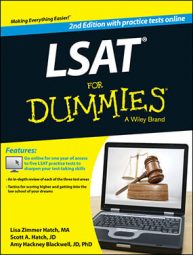You will encounter reading comprehension questions on the LSAT. These questions require you to read a longer passage and choose the best answer to questions about the passage. Give these sample questions a try.
Reading comprehension sample questions
Biologists often fail to recognize the importance of a species to an ecosystem until that species is no longer present in the ecosystem. A case in point is that of the long-spined sea urchin, Diadema antillarum. Scientists and fishermen long considered the sea urchin a spiky pest that served no useful purpose; recreational divers would even feed sea urchins to fish just for fun.
The last 20 years, however, have proven that the sea urchin does indeed play a valuable role in the marine environment.
Sea urchins are members of the phylum Echinodermata, the category of invertebrate animals with spiny exterior shells, which also includes starfish, brittle stars, and sand dollars. Sea urchins have a spherical body contained in a hard shell that is covered with long sharp spines. They walk around on shorter spines located on the underside of their bodies.
A sea urchin's mouth is also located on its underside; this mouth is a five-toothed structure called Aristotle's Lantern, adapted to scraping algae and organic matter from rocks and corals. Sea urchins eat a vast amount of algae.
Exactly how much algae they consume has become clearer in the past two decades because urchins have virtually disappeared from many Atlantic environments. In 1983, a barge traveled from the Pacific to the Atlantic through the Panama Canal carrying a bacterium that proved devastating to the sea urchin population. Nearly all long-spined urchins in the tropical western Atlantic died as a result of this exposure.
Without sea urchins to eat the algae, aquatic greenery grows out of control. It has completely covered some coral reefs. In Jamaica, before the sea urchins died off, algae covered just 1 percent of shallow reefs, but two years after the plague, it covered nearly 95 percent of shallow coral. Many reefs in the Bahamas have abruptly transformed from multicolored undersea wonderlands into monochromatic mossy-looking hillocks.
Coral that is covered by algae quickly dies, unable to receive necessary sunlight and nutrients from the water. The algae cover also makes it difficult for both corals and sea urchins to breed, because their larvae cannot find a clean surface on which to anchor.
Scientists have completely changed their views of sea urchins from that of the early 1980s. Sea urchins are one of the first organisms to show signs of stress when water quality is bad, so the Environmental Protection Agency has begun monitoring sea urchins as an indicator of water conditions.
Other scientists have taken on the task of redistributing the remaining sea urchins to endangered coral reefs. They hope that the sea urchins will clean off the reefs and make it possible for both coral and sea urchins to breed successfully and restore the marine environment to its healthy state.
Which one of the following most accurately expresses the main point of the passage?
(A) Events of the last two decades have shown that sea urchins play a vital role in the maintenance of the ecosystems in which they live, contrary to what many scientists formerly assumed.
(B) It is the duty of responsible scientists to manipulate environments to ensure that they remain in ecological balance, such as by transporting sea urchins to reefs that have become overgrown with algae.
(C) Members of the phylum Echinodermata are often underappreciated but are extremely important to the health of coral reefs.
(D) Excessive algae growth is a severe problem in the tropical western Atlantic, and if governments fail to take action in the very near future, all the coral reefs in that area could die.
(E) Governments should educate their citizenry on the importance of keeping ecosystems in balance because this will help prevent people from abusing natural resources or introducing foreign substances that might be dangerous to local plants and animals.
The primary purpose of the second paragraph is to
(A) support the claim that sea urchins are important to their ecosystems
(B) describe the appearance and eating habits of sea urchins
(C) argue that the loss of sea urchins is devastating to the overall ecosystem
(D) illustrate the attitude of scientists toward invertebrates
(E) suggest that other members of the phylum Echinodermata might also eat algae
Based on the passage, which one of the following best describes the relationship between sea urchins, starfish, brittle stars, and sand dollars?
(A) They are all invertebrates that eat algae.
(B) They were all devastated by the bacterium that entered the Atlantic in 1983.
(C) They are all members of the same phylum.
(D) They are all covered with long, sharp spines.
(E) They can all be divided into five segments that radiate out from a center point.
According to the passage, what happened to the sea urchin population in the tropical western Atlantic in the mid-1980s?
(A) Fishermen and water sports enthusiasts systematically killed them off, hoping to eradicate what they believed was a pest.
(B) A plague killed the coral, which became so covered with algae that sea urchins could no longer reproduce.
(C) A sudden increase in triggerfish, one of the main predators of sea urchins, resulted in most juvenile sea urchins being eaten before they could reach breeding age.
(D) A virus spread by other echinoderms caused sea urchins from the Bahamas to Jamaica to sicken and die.
(E) A bacterium carried by a ship entering the Atlantic from the Pacific spread throughout the population and killed nearly all sea urchins.
Answers
A
B
C
E

